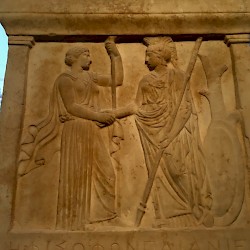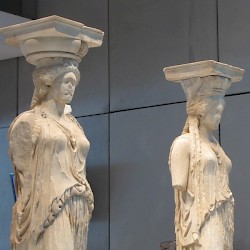Athens, Acropolis Museum
Q421084I had been looking forward to our visit to the Acropolis Museum, because I had read several very favorable reviews. It is indeed splendid. One of the reasons for building it is that Greece wants the Elgin Marbles back, and that the British Museum has often argued that the Greeks cannot really take care of antiquities. So, the Greeks decided to build the best museum in the world, and they’ve succeeded wonderfully. Unlike the old building, which was too small (another reason to build something else) the new Acropolis Museum, made from steel, concrete, and glass, is spacious and light.
More importantly, they have really thought about everything. It is built on top of an archaeological site, and the museum has on many places a glass floor, to make you realize that you’re literally standing on the past. Or take the entrance, where you will find several banks in a semicircle, where students can sit down (as if in a theater) and a teacher can explain something. There’s a photo of the Acropolis, a model, a bust of Pericles, a relief of a triere, some objects illustrating the democratic process. In this way, no one needs to enter the museum without knowing why fifth- and fourth-century Athens mattered and why this museum was built.
The first room is actually the gentle stairway to the first floor; to your left and right you see lots of Archaic and Classical pottery. For a moment, we were reminded of a storage room and the Egyptian Museum in Cairo, but in the end, the sheer amount of beautiful ceramics was not too much to stomach. Once upstairs, you’ve reached a giant room full of Archaic statues – the korai, the horsemen, the pediments, the gods, the heroes, and the “Kritios boy”. It was all destroyed by the Persians and stored away in large pits, forgotten, and found again by nineteenth-century archaeologists.
On the same level is the collection of Classical art, where you will find, among many other things, the famous frieze of the temple of Nike and lots of other sculpture. The most recent objects are Roman. For the Christian additions to the Parthenon you will have to go to the Byzantine Museum, which is just as nice as the Acropolis Museum. The Caryatides from the Erechtheion have received a special place, where you can see them from all sides. I had never realized that the girls have splendid hair.
Almost nowhere are the objects hidden behind glass. If you want to, you might touch the objects, but the museum trusts people to act responsibly, and I agree that we should have some confidence in people. Sometimes, there may be someone who touches something, but placing everything behind glass will destroy the visitors’ experience of all those beautiful statues. That’s like killing a statue, which I find worse than that someone occasionally touches it.
On the second floor – look through the glass floor to see the Caryatides from above! – is a restaurant with a splendid view of the Acropolis, plus a small bookshop. Moving up again, you reach the hall where the remains of the two pediments and the two friezes are displayed. The Greeks hope that one day, the Elgin Marbles will be here. Until then, you will see replicas with the optimistic explanatory sign “Cast (temporary)”.
The Akropolis Museum is beautiful. It is the best museum I know. It is a triumph. But triumphs are always bought at a price, and this museum is not perfect either. One lady in my company, who suffers from mild agoraphobia, started to feel sick in those spacious rooms, which was acerbated by the fact that it was warmer than is customary in a museum. I won’t blame the architect for creating an open building, but the climate system may indeed suffer from some children’s diseases. Another detail that can be improved easily is the sound of the (excellent!) movie that is shown on the third floor: it is too loud, so that people who are trying to see the two models of the pediments opposite the movie screen, are distracted. Finally, I found it odd that the museum hardly sold English books or a DVD of that movie.
Yet, these are trivialities. The only real criticism is that photography is forbidden – something that ought to be outlawed anyhow, but is particularly silly in a museum that stresses that the Parthenon is World Heritage. We should all be able to study it, we must all be able to take photos of the details we think are important – especially if you cannot even buy a catalog, which is a poor substitute anyhow, because the photographer never focuses on the details you find interesting. Museums must not obstruct study.
So, I will have to go back to study everything again. But going back there is something pleasant. The Akropolis Museum is beautiful. It is the best museum I know. It is a triumph.
This museum was visited in 2010.
3 pictures related to this museum
 Athens, Acropolis, Samian decrees |
 Athens, Acropolis, Erechtheion, the Caryatids |
 Athens, Acropolis, Portrait of Alexander the Great |